The understory of a forest includes everything beneath the canopy which is formed by the tops of the largest trees. The understory is composed of several structural layers that can have very distinctive plant communities. The sub-canopy is composed of smaller trees that may eventually make it to the canopy. The sapling layer is also generally composed of smaller trees that have grown above the tree seedling layer but have not yet reached the sub-canopy (Read more about the structure of trees in a hardwood forest, and how earthworms affect them).
In addition to tree species, the forest understory plant community is composed of a variety of herbaceous plants, mosses & lichens, and shrubs. When earthworms invade a previously earthworm-free hardwood forest, we can see big changes in the structure (layers) and composition of the understory plant communities.
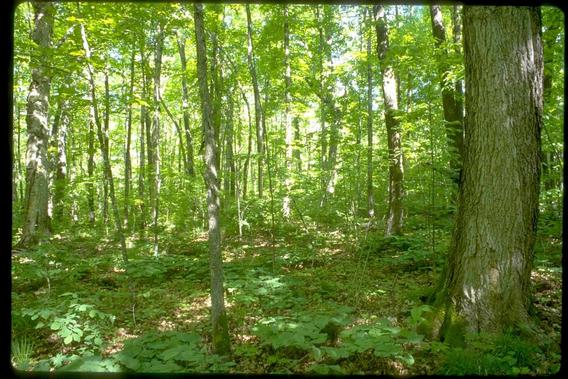
|
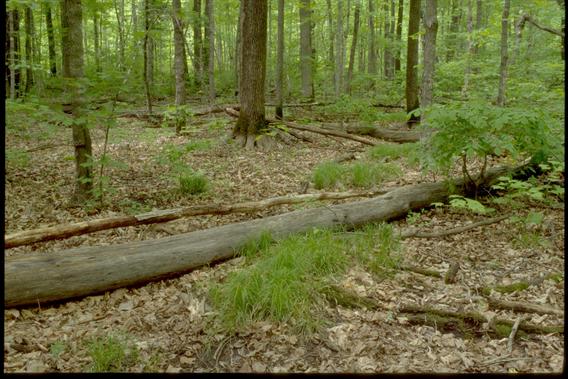
|
Herbaceous plants include all non-woody plant species (except mosses) such as forbs (flowering plants), grasses and grass-like plants, and ferns that grow in the forest (species lists). Most herbaceous plants in hardwood forests of the Great Lakes Region are perennial plant species that root almost exclusively in the thick forest floor of an earthworm-free hardwood forest… read more about perennial plants. This sets the stage for big effects when earthworms invade and rapidly consume that forest floor, literally eating the rooting zone out from under the established plants causing a wave of plant morality.
Mosses and Lichens are common and very diverse (though under appreciated) in hardwood forests across the Great Lakes region. They differ functionally from herbaceous and woody plants in that they have no vascular tissue*. They require moist conditions and often grow and reproduce on decaying litter and logs. When earthworms invade a forest and remove the forest floor, observations suggest that moisture levels also decline. A decreases in moisture levels in combination with the loss of the forest floor as a rooting substrate, suggests that mosses and lichens may suffer following earthworm invasion, but no research on this exists yet.
*Vascular tissue refers to the veins inside the stems of most plants that pump nutrients and water up from the roots to leaves. Mosses don’t have such veins, instead they transfer nutrients and water from one cell to another. However, this process is limited by gravity, which explains why moss is found growing low to the ground in moist places.
Shrubs are woody species of plants that do not grow into trees. They tend to grow as small to medium sized bushes. There are many shrubs that grow in hardwood forests with some of the more familiar being Raspberry, Gooseberry and Hazelnut. Birds and other forest animals rely on the shrub community for food and nesting sites. The jury is still out on whether earthworm invasions affect shrub communities. The research so far suggests that overall cover of shrubs does not change but some changes in species composition may be occurring. More work is needed.
After initial earthworm invasion, what other changes in the forest affects plant communities?
Following earthworm invasion, the conditions in the forest floor and soil have been changed dramatically, changing the rules of the game for survival in the forest… read more. There are several changes that appear to affect the survival and persistence of native forest plants including:
Changes in seedbed conditions may decrease seed germination and survival rates
Prior to earthworm invasion the thick forest floor provided protection to the seeds, seedlings and roots of understory plants. They were protected from cold and freezing during the winter, excessive heat and drying during the summer and from predation by small mammals, birds and other critters that might eat seeds and plant roots. This may be particularly important for long-lived perennial plants that often have very complex seed dormancy and germination strategies.
Unlike the seeds you buy at the garden center, many hardwood forest perennial plants have seeds that require 1, 2 or even 3 freeze-thaw cycles in order to fully germinate. During this long germination phase, they need protection. It is unclear how well these plants germinate and establish from seeds after earthworm invasion and much more research is needed.
Decreased nutrient availability following earthworm invasion
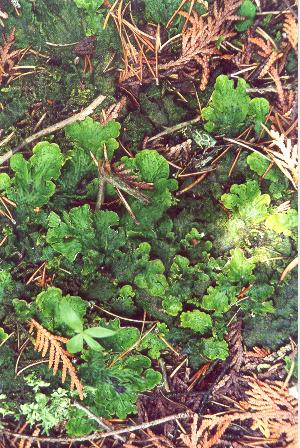
In earthworm-free hardwood forests, plants root extensively in the thick forest floor because that is where most of the available nutrients are found (what do you mean by “available” nutrients?). Roots extend into the mineral soil below largely for access to water or to anchor the plant. Contrary to results from agricultural ecosystems, earthworm invasions in hardwood forests have been shown to be associated with declines in nitrogen and phosphorous availability. This appears to be due to both increased leeching losses and increased immobilization (absorbtion) by microorganisms as the forest floor gets mixed into the upper soil horizons… read more.
Changes in the availability of nitrogen and phosphorous can affect plants because they are the two most common limiting nutrients for plant growth. A limiting nutrient is a nutrient that the organism needs to function but the supply of that nutrient is less than the demand, which “limits” the plants growth. Different plants have different levels of need for nitrogen and other nutrients so changes in the availability of these nutrients can favor some plants over others.
Changes in mycorrhizal fungi populations and root colonization rates
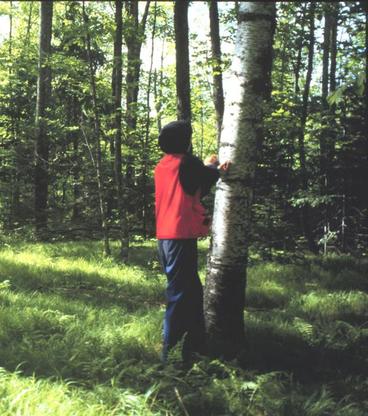
The vast majority of native understory plants in northern temperate hardwood forests are strongly mycorrhizal. That means that their roots form a symbiotic relationship with mycorrhizae fungi which is important for acquiring the nutrients and water they need for germination and growth… read more. Grazing by earthworms can lead to declines in the abundance and changes in the composition of the soil fungal community and earthworms have been shown to decrease mycorrhizal colonization rates of sugar maple seedlings. Both of these results suggest that declines in abundance of mycorrhizal fungi or other shifts in the fungal community may be contributing to changes in the understory plant community. For example, the grass-like species Pennsylvania sedge (Carex pensylvanica), is common in earthworm-free forests across the Great Lakes region, but usually occurs at low densities. It is also one of a few non-mycorrhizal native plant species in these forests. When earthworms invade, Carex can begin to dominate and can form a nearly continuous carpet where a diverse herbaceous community previously existed. The formation of these Carex carpets can negatively affects tree seedling regeneration and restoration efforts for other native plant species.
Increased impacts of deer grazing
Studies abound across the Great Lakes region demonstrating how white-tailed deer browsing can affect understory plant communities. Some plants are more strongly affected by deer browsing than others. For example, deer love to eat plants like Trillium, a beloved spring flower that can be dramatically affected by deer browsing because the deer can clip the whole flowering and fruiting part of the plant in one bite. If a Trillium is browsed in several consecutive growing seasons, the root stores of energy are depleted. Larger plants and plants that have multiple flowering parts or that can regrow rapidly after being browsed have an advantage where deer browsing is heaviest.
After earthworm invasion, the impacts of browsing by white-tailed deer on the understory plant community can be even greater because the plant populations have been reduced during initial invasion… read more.
Research suggests that the combination of earthworms and deer can lead to the elimination of some plant species when they might persist if only faced with deer or earthworms alone. The wave of plant mortality associated with initial earthworm invasion can decrease the plant population to a point where it can no longer recover from the impacts of deer browsing, even if there is no change in the level of deer browsing before and after earthworm invasion.
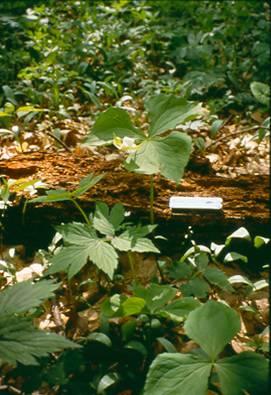
|
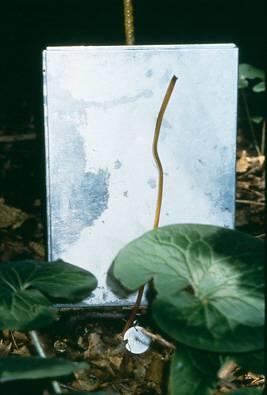
|
Plants with Secondary Compounds may be less impacted by earthworm invasions
Jack-in-the-Pulpit (Arisaema triphyllum)is one of several native forest plant species that has bitter tasting or toxic substances in their leaves, called secondary compounds. Many exotic plant species also contain secondary compounds giving them an edge when invading. Deer and other herbivores will avoid eating these plants. If the pressure of deer browsing is great enough, after some time, these plant species may take over the forest understory.
Plants with high levels of secondary compounds are generally not grazed by herbivores and their rhizosphere (roots and the 1mm or so of soil surrounding the roots) may be avoided by earthworms as well. Root herbivory and changes in the rhizosphere can result in decreases in plant growth and diversity. In a study in northern Minnesota, Jack in the Pulpit (Arisaema triphyllum) and Ramps or wild leeks (Allium tricoccum) were positively associated with increasing earthworm biomass and both contain toxic compounds that may inhibit grazing in the rhizosphere by earthworms. A. triphyllum contains oxalic acids and the roots are reported to be the most toxic part of the plant. A. tricoccum contains large amounts of thiosulfinates and other sulfur compounds that have been shown to be toxic to insects and they may also be toxic to earthworms. While toxic compounds in these species may minimize direct effects of earthworm grazing, changes in soil structure and chemistry may still have affects. For example, both A. triphyllum and A. tricoccum the least abundant in nearly earthworm-free conditions and where earthworm biomass and diversity were the highest suggesting that an initial enhancement may be occurring early on in the earthworm invasion followed by declines in these species after large persistent earthworm populations had become established.
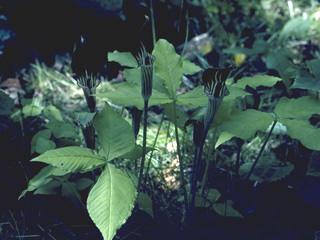
|
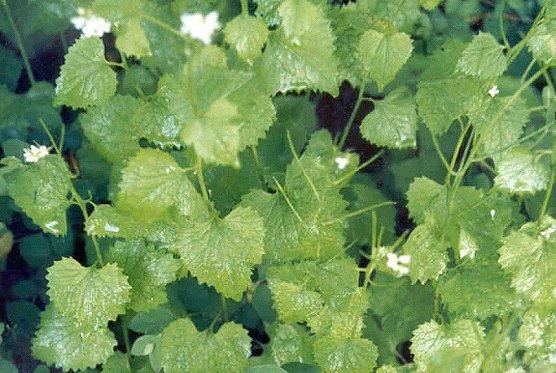
|
Changes in light levels on the forest floor may favor non-native plant species
Following earthworm invasion, declines in tree seedlings, saplings and canopy limbs can lead to greater light levels on the forest floor… read more. Many native understory plants of hardwood forests are quite shade tolerant. These plants have adapted to survive and thrive at light levels too low for many other plants to survive (as low as 2% of full sun). Non-native plant species tend to be less shade tolerant than the natives and even small increases in light levels can give the exotics a big advantage.